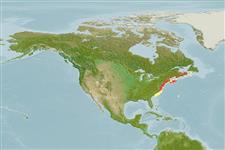Common names from other countries
Environment: milieu / climate zone / depth range / distribution range
Ecologia
marinhas; Água doce; estuarina bentopelágico; anádromo (Ref. 51243); intervalo de profundidade 0 - 10 m (Ref. 7251). Temperate; 10°C - 33°C (Ref. 121663); 50°N - 32°N, 96°W - 59°W
North America: Atlantic Slope drainages from St. Lawrence drainage in Quebec, Canada south to Savannah River in Georgia, USA. Transplanted to Great Lakes (except Superior) and Ohio-Missouri-Mississippi river systems of mid-western USA; elsewere as far west as Colorado, USA.
Tamanho / Peso / Idade
Maturity: Lm ? range ? - ? cm
Max length : 58.0 cm TL macho/indeterminado; (Ref. 86798); common length : 13.5 cm TL macho/indeterminado; (Ref. 12193); peso máx. publicado: 2.7 kg (Ref. 120584); idade máx. registrada: 16 anos (Ref. 72462)
Occurs in fresh, brackish and coastal waters (Ref. 7251). Inhabits pools and other quiet-water areas of medium to large rivers, usually over mud (Ref. 86798). Neither anterolateral glandular groove nor venom gland is present (Ref. 57406).
Assuming same mode of reproduction as in M. saxatilis.
Page, L.M. and B.M. Burr, 2011. A field guide to freshwater fishes of North America north of Mexico. Boston : Houghton Mifflin Harcourt, 663p. (Ref. 86798)
Status na Lista Vermelha da UICN (Ref. 130435)
CITES (Ref. 128078)
Not Evaluated
Ameaça para os humanos
Harmless
Uso pelos humanos
Pescarias: pouco comercial; peixe esportivo: sim; Aquário: Aquários públicos
Ferramentas
Relatórios especiais
Baixar XML
Fontes da internet
Estimates based on models
Preferred temperature (Ref.
115969): 4.7 - 18.2, mean 10.2 (based on 64 cells).
Índice de diversidade filogenética (Ref.
82804): PD
50 = 0.5781 [Uniqueness, from 0.5 = low to 2.0 = high].
Bayesian length-weight: a=0.00447 (0.00185 - 0.01077), b=3.13 (2.91 - 3.35), in cm Total Length, based on LWR estimates for this (Sub)family-body shape (Ref.
93245).
Nível Trófico (Ref.
69278): 3.1 ±0.35 se; based on food items.
Resiliência (Ref.
120179): Baixo, tempo mínimo de duplicação da população 4,5 - 14 anos (K=0.07-0.13; tmax=7(?)).
Fishing Vulnerability (Ref.
59153): High to very high vulnerability (69 of 100).
Climate Vulnerability (Ref.
125649): Moderate to high vulnerability (52 of 100).
